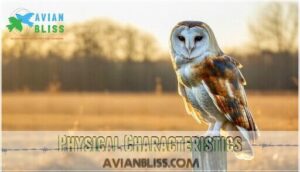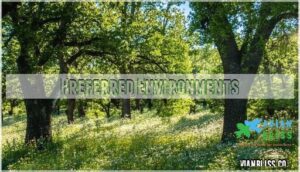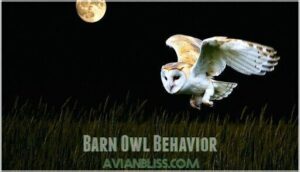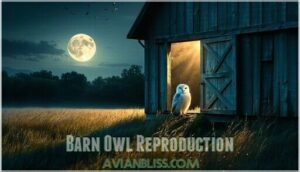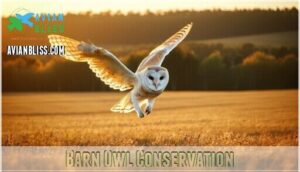This site is supported by our readers. We may earn a commission, at no cost to you, if you purchase through links.

These medium-sized raptors weigh just 1 pound but pack incredible hunting skills. They fly silently through the night using specialized feathers that muffle sound.
Barn owls live on every continent except Antarctica and Australia. They prefer open grasslands and farmlands where they hunt mice and voles.
Their excellent hearing helps them catch prey in complete darkness. These owls nest in barns, old buildings, and tree cavities.
A single barn owl can eat over 1,000 rodents per year. Their haunting screeches and ghostly appearance make them unforgettable nocturnal neighbors with remarkable pest control abilities.
Table Of Contents
- Key Takeaways
- Barn Owl Identification
- Barn Owl Habitat
- Barn Owl Behavior
- Barn Owl Reproduction
- Barn Owl Conservation
- Frequently Asked Questions (FAQs)
- What is special about a barn owl?
- Is it good to see a barn owl?
- Is it rare to see a Barn Owl?
- Where do barn owls live in the US?
- Are barn owls good or bad?
- Why isn’t a Barn Owl a true owl?
- Can barn owls see in complete darkness?
- How long do barn owls live in the wild?
- Are barn owls known to be aggressive birds?
- Do barn owls make good pets or not?
- Conclusion
Key Takeaways
- You’ll recognize barn owls by their distinctive heart-shaped white face and silent flight, making them unmistakable nocturnal hunters with specialized feathers that muffle sound completely.
- You’ll find these adaptable birds on every continent except Antarctica, thriving in open grasslands and farmlands where they provide excellent natural pest control by catching over 1,000 rodents per year.
- You’ll discover their exceptional hunting abilities come from asymmetric ear openings that create perfect stereo hearing, allowing them to pinpoint prey in complete darkness with 90% strike accuracy.
- You’ll need to support conservation efforts since barn owls face serious threats from habitat loss, rodenticides, and vehicle collisions, though nest box programs have successfully increased populations by 250% in suitable areas.
Barn Owl Identification
You’ll recognize barn owls by their striking heart-shaped white face and pale underparts contrasting with golden-brown backs.
These medium-sized owls measure 12.6-15.8 inches long with a 39.4-49.2 inch wingspan and weigh 14.1-24.7 ounces.
Physical Characteristics
You’ll spot a barn owl by its distinctive size and shape.
These medium-sized owls measure 12-16 inches long with a 39-49 inch wingspan.
Their heart-shaped facial disc creates perfect sound-gathering abilities.
The owl plumage shows striking white underparts contrasting with golden-brown backs.
Long legs extend below their rounded wings during flight.
This owl anatomy makes them unmistakable among North American species, with a heart-shaped facial disc and distinctive size.
Distinguishing Features
You’ll recognize a barn owl by its heart-shaped face and dark eyes.
The facial discs help funnel sound to asymmetric ears for precise hunting.
Notice their feathered legs extending to the toes and distinctive loping flight pattern.
These medium-sized birds measure 12-16 inches long with crow-like proportions, making size comparison easier during bird identification in open habitats.
Plumage Variations
Barn Owl subspecies plumage shows remarkable regional differences across their global range.
You’ll notice color morphs varying from pale white birds to those with rich tawny coloration on their upperparts.
The Lesser Antilles group displays a distinctive brownish face and dark upperparts.
Feather patterns differ substantially between subspecies groups.
Genetic influence creates these bird color variations you observe worldwide.
Examining their contour feather patterns can further help distinguish subspecies with unique feather patterns.
Barn Owl Habitat
You’ll find barn owls on every continent except Antarctica, making them the world’s most widespread owl species.
These adaptable birds thrive in open habitats like grasslands, farms, marshes, and deserts from sea level up to 13,000 feet in the Andes Mountains.
Global Distribution
Across six continents, you’ll find barn owls thriving everywhere except Antarctica.
This remarkable continental presence spans from Canada to Argentina in the Americas. Twenty-eight subspecies ranges vary dramatically across regions.
Each subspecies shows unique habitat variation from tropical rainforests to semi-arid deserts.
Migration patterns remain minimal since barn owls don’t migrate seasonally.
Elevation limits keep most populations below 2,000 meters altitude.
Preferred Environments
You’ll find these owls thriving in open landscapes where hunting opportunities abound.
Grasslands and agricultural fields provide ideal owl habitat with abundant rodents.
Barn owls prefer low elevations below 13,000 feet and seek nesting proximity to food sources.
Their habitat diversity spans deserts to marshes across six continents.
Despite urban adaptation challenges, regional absence occurs where suitable farmland bird environments lack proper shelter for consistent owl sightings.
Consider exploring owl habitat products for supporting these creatures.
Adaptability to Urban Areas
You’ll find these adaptable birds thriving in cities worldwide.
Urban barn owls hunt rats and mice near streetlights and nest in abandoned buildings.
They face challenges from light pollution disrupting their nocturnal hunting patterns and increased road mortality from vehicle strikes.
Despite these obstacles, barn owls provide excellent rodent control in urban environments through successful human interaction and habitat modification.
Urban birds often show behavioral adaptations for survival, which is a key factor in their ability to thrive in urban environments with successful human interaction.
Barn Owl Behavior
You’ll discover that barn owls are perfectly designed nocturnal hunters that glide silently through darkness using specialized flight feathers and asymmetric ear openings.
These ghost-like predators hunt primarily rodents like voles and mice by flying low over open ground and striking with deadly precision.
Nocturnal Lifestyle
Under cover of darkness, you’ll discover the barn owl transforms into nature’s most efficient nocturnal hunter.
These specialized predators have evolved remarkable adaptations for their nighttime lifestyle.
Here are four key aspects of their nocturnal behavior:
- Sleep Patterns – Barn owls rest during daylight hours in hidden roosts like tree cavities or barn lofts
- Sensory Adaptations – Asymmetric ear openings provide precise hearing while large eyes gather maximum light
- Hunting Hours – Peak activity occurs between dusk and dawn when prey is most active
- Nighttime Communication – Raspy hisses and shrieking calls help locate mates and defend territory
Hunting Techniques
You’ll witness nature’s most precise hunter using Silent Flight to glide soundlessly through darkness.
Asymmetric Hearing pinpoints prey location with deadly accuracy.
Their specialized feathers eliminate wing noise during nocturnal hunting.
Strike Accuracy reaches 90% success rates within their Hunting Range.
Prey Specialization focuses on small mammals through advanced Prey Capture techniques.
Barn owls achieve this quiet flight with specially adapted feathers.
| Hunting Feature | Function | Effectiveness |
|---|---|---|
| Silent Flight | Noise-free wing movement | 100% stealth approach |
| Asymmetric Hearing | Sound triangulation | Pinpoint prey location |
| Strike Accuracy | Precise talon placement | 90% success rate |
| Hunting Range | Territory coverage | 2-5 mile radius |
Prey Species
You’ll notice barn owls aren’t picky eaters in regards to their owl diet.
Small mammals make up 96% of their meals.
Rodents like voles and mice dominate their hunting success.
Here’s what fills their bellies:
- Vole Dominance – These small mammals top the menu in rural areas
- Rodent Variety – Rats and mice provide steady prey availability
- Insect Consumption – Beetles and moths supplement spring diets
- Bird Hunting – Songbirds make up less than 6% of meals
- Seasonal Shifts – Winter brings more alternative prey when snow covers rodents
Urban barn owls, however, may consume more rats, increasing their disease exposure risk.
Barn Owl Reproduction
You’ll find barn owls have fascinating reproductive behaviors that help them thrive across different environments.
Their breeding cycle includes unique courtship displays, flexible nesting choices, and timing that matches food availability in their territory, which is a key aspect of their breeding cycle.
Mating and Courtship
Barn owls form strong pair bonds through elaborate courtship displays during breeding season.
Males perform aerial acrobatics and present prey gifts to potential mates. These monogamous birds engage in mutual preening and synchronized calling.
Successful courtship rituals lead to mate selection based on territory quality and hunting ability.
Their pair bonding strengthens through shared responsibilities throughout the lengthy breeding cycle.
Nesting Sites
You’ll discover barn owls choose diverse nesting sites for breeding success.
These adaptable birds select hollow trees, cliffs, barn lofts, and church steeples.
Artificial nests and nest boxes provide excellent alternatives when natural cavities aren’t available.
Site elevation typically reaches at least 3 meters above ground for protection.
Nest site selection depends on safety from predators and proximity to hunting grounds.
Barn owls don’t gather nest materials, preferring bare surfaces in their chosen locations.
These owls often utilize abandoned nests of other birds, which can be a key factor in their breeding success.
Egg Laying and Incubation
Female barn owls typically lay 3-7 white eggs in their chosen nesting cavity.
The incubation period lasts 29-34 days with the female handling most duties.
Males provide food while females rarely leave the nest.
Eggs hatch asynchronously creating size differences among chicks.
Here’s what you need to know about owl nesting and reproduction:
- Clutch size varies from 2-12 eggs depending on food availability
- Incubation begins immediately after the first egg is laid
- Egg composition includes calcium carbonate shells measuring 1.6 inches long
- Hatching success rates reach 80-90% under favorable conditions
- Parental roles divide clearly with males hunting and females brooding
Barn Owl Conservation
You’ll discover barn owls face serious conservation challenges across their global range.
These remarkable hunters need your awareness of population declines and habitat protection efforts to guarantee their survival for future generations.
Population Trends
Worldwide barn owl population ranges from four to ten million individuals.
You’ll find stable population trends globally despite regional variations.
North American populations hover around 140,000 birds while Europe shows recovery from historical declines.
Habitat Loss and Climate Change affect local numbers.
Some regions report declining population trends while others show increasing population stability through conservation efforts.
These owls are found across continents except Antarctica, experiencing Habitat Loss and having a population of around 140,000 birds.
Threats and Challenges
Multiple threats endanger barn owl populations worldwide.
Habitat Loss from agricultural intensification removes 67% of foraging grasslands.
You’ll find these major challenges affecting barn owl conservation:
- Rodenticides – 90% of barn owls contain anticoagulant residues causing internal bleeding
- Vehicle Collisions – Road mortality accounts for 56% of annual deaths
- Climate Change – Storms reduce juvenile survival by 30%
- Prey Scarcity – Pesticides decrease small mammal populations
Conservation Efforts
Barn owl conservation efforts include habitat preservation through over 30 global programs.
Nest box programs achieve 250% population increases in cavity-poor areas. The Barn Owl Conservation Network installed 26000 boxes since 1995.
Agricultural partnerships reduce pesticide use by 45% through integrated pest management.
Public awareness campaigns generate 10 million annual webcam views. You can even find a suitable barn owl nestbox to help with conservation.
IUCN supports climate change adaptation strategies for sustainable owl conservation worldwide.
Frequently Asked Questions (FAQs)
What is special about a barn owl?
You’ll discover these nocturnal hunters possess heart-shaped faces that act like satellite dishes, collecting sound waves to pinpoint prey in complete darkness.
Their asymmetric ear openings create perfect stereo hearing for silent hunting, utilizing a unique biological feature to enhance their nocturnal abilities with asymmetric ear openings.
Is it good to see a barn owl?
Seeing a barn owl is generally positive.
You’re witnessing nature’s efficient nocturnal hunter with its heart-shaped face and silent flight.
These encounters indicate healthy ecosystems and open habitats where they thrive hunting rodents, signifying a balance that supports the presence of such a nocturnal hunter.
Is it rare to see a Barn Owl?
Spotting one isn’t extremely rare, but it’s uncommon in many areas.
You’ll have better luck in open farmland and grasslands where they hunt mice at night.
Their silent flight and nocturnal habits make encounters special when they happen.
Where do barn owls live in the US?
You’ll find them across most US states except the northernmost regions. They live year-round in Texas, Arizona, Pennsylvania, and the Pacific Northwest, preferring open farmland, grasslands, marshes, and agricultural areas.
Are barn owls good or bad?
Like guardians of the night, you’ll find barn owls are incredibly beneficial.
They’re nature’s pest control, silently hunting rodents that damage crops and spread disease.
A single owl catches thousands of mice yearly, protecting your food supply and reducing agricultural losses naturally.
Why isn’t a Barn Owl a true owl?
Barn Owls are actually true owls, belonging to the family Tytonidae rather than Strigidae like most owls.
You’ll notice they’re distinguished by their heart-shaped facial discs and unique ear arrangements for precise hunting abilities.
Can barn owls see in complete darkness?
Like a night vision superhero, you can’t see in complete darkness because barn owls need some light to hunt.
Their asymmetric ear openings and precise hearing help them locate prey even when their exceptional vision can’t quite cut it in pitch-black conditions, utilizing their exceptional vision to the fullest extent possible in available light.
How long do barn owls live in the wild?
Wild barn owls typically live 4-10 years, though you’ll find some exceptional individuals reaching 15-20 years. Their lifespan depends heavily on predation, disease, and habitat quality in their territory.
Are barn owls known to be aggressive birds?
Surprisingly gentle, you’ll find these nocturnal hunters aren’t typically aggressive toward humans. They’ll hiss and display defensive postures when threatened, but they’re more likely to flee than fight back.
Do barn owls make good pets or not?
You shouldn’t keep barn owls as pets.
They’re wild birds that need hunting space, live prey, and specialized care.
It’s illegal in most places and harmful to their well-being and natural behaviors.
Conclusion
Despite common misconceptions that barn owls are hard to find, you’ll discover these remarkable hunters across diverse landscapes worldwide.
Understanding barn owl identification and behavior helps you appreciate their ecological importance.
These silent predators control rodent populations naturally while adapting to changing environments, with their distinctive heart-shaped faces and ghostly flight patterns making them unforgettable.
Conservation efforts guarantee future generations will witness barn owl hunting prowess, and you’ve learned essential facts about these nocturnal neighbors who provide invaluable pest control services.

